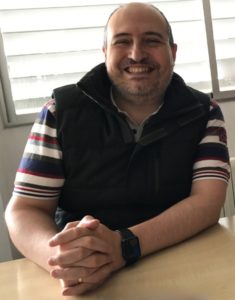Dr. Resano is Professor in the Department of Analytical Chemistry and member of the I3A research institute at the University of Zaragoza, where he leads the group M.A.R.T.E., that investigates the capabilities and limitations of atomic spectrometry techniques for bulk and spatially resolved trace and isotopic analysis. Current focus is in a) the detection and quantification of nanomaterials; b) the development of minimally invasive methods for analysis of biological fluids; c) the potential of high-resolution graphite furnace molecular absorption spectrometry for elemental and isotopic analysis.
Read Professor Resano’s Editor’s Choice selection via the links below – all articles are free to access for the next 4 weeks!
Separation and detection of gold nanoparticles with capillary electrophoresis and ICP-MS in single particle mode (CE-SP-ICP-MS)
Franze et al., J. Anal. At. Spectrom., 2017, DOI: 10.1039/c7ja00040e
This article explores for the first time the coupling of CE with ICP-MS operating in single particle mode, such that information on particle number, particle mean size, size distribution, and elemental composition can be visualized in 3-D single-particle electropherograms. A brilliant idea that follows the trend of adding extra dimensions to separation techniques, in order to achieve better resolution and more information.
Evaluation of a compact VUV spectrometer for elemental imaging by laser-induced breakdown spectroscopy: application to mine core characterization
Trichard et al., J. Anal. At. Spectrom., 2017, DOI: 10.1039/c7ja00185a
Imaging is a field in which the use of LIBS can represent a breakthrough because of its simplicity, sample throughput and cost-effectiveness. This work is a clear example of the potential of this technique.
Depth profiling of nanometer thin layers by laser desorption and laser postionization time-of-flight mass spectrometry
Yin et al., J. Anal. At. Spectrom., 2017, DOI: 10.1039/c7ja00081b
A very impressive work on the performance of a new technique, laser desorption and laser postionization time-of-flight mass spectrometry, for depth profiling of thin layers of Ni and Ta, providing in-depth full isotopic spectra with an average ablation rate as low as 0.026 nm per laser pulse.
Novel non-target analysis of fluorine compounds using ICPMS/MS and HPLC-ICPMS/MS
Jamari et al., J. Anal. At. Spectrom., 2017, 32, 942-950, DOI: 10.1039/C7JA00051K
A good example of how elemental information that is nearly impossible to achieve in a conventional way can instead be obtained, in an ingenious way, via the monitoring of molecular species. Plus, a good illustration of the upcoming importance of speciation of non-metals.
Sizing gold nanoparticles using graphite furnace atomic absorption spectrometry
Leopold et al., J. Anal. At. Spectrom., 2017, 32, 723-730, DOI: 10.1039/C7JA00019G
Another brilliant example of innovation, proving how an “old-fashioned” technique can provide new information, in this case enabling the selective detection and quantification of AuNP of different sizes, in the range between 2 and 100 nm.











